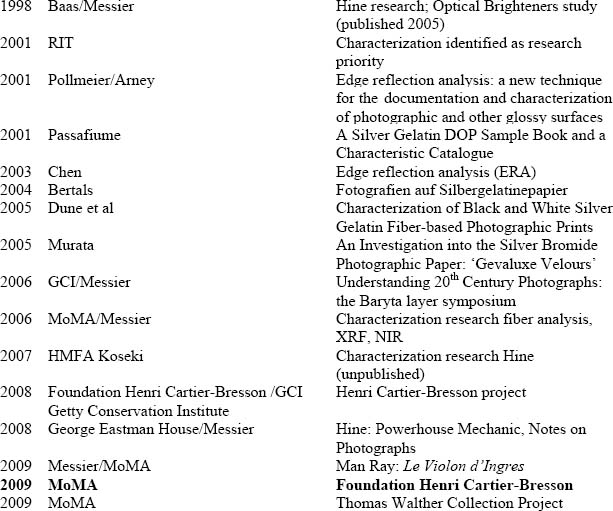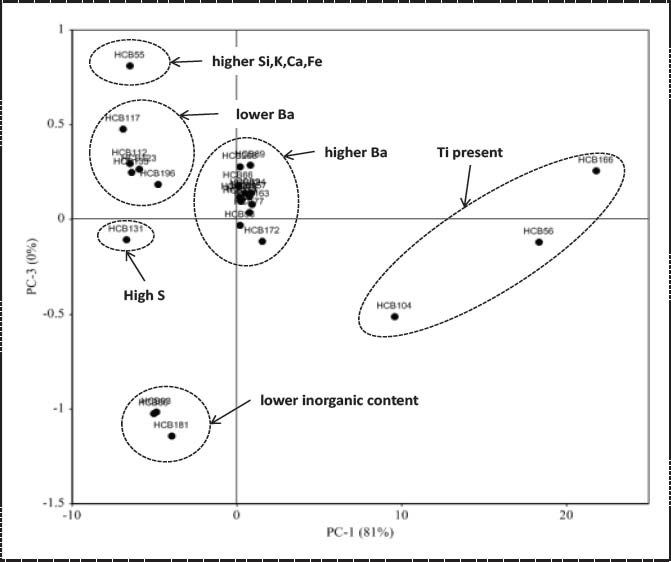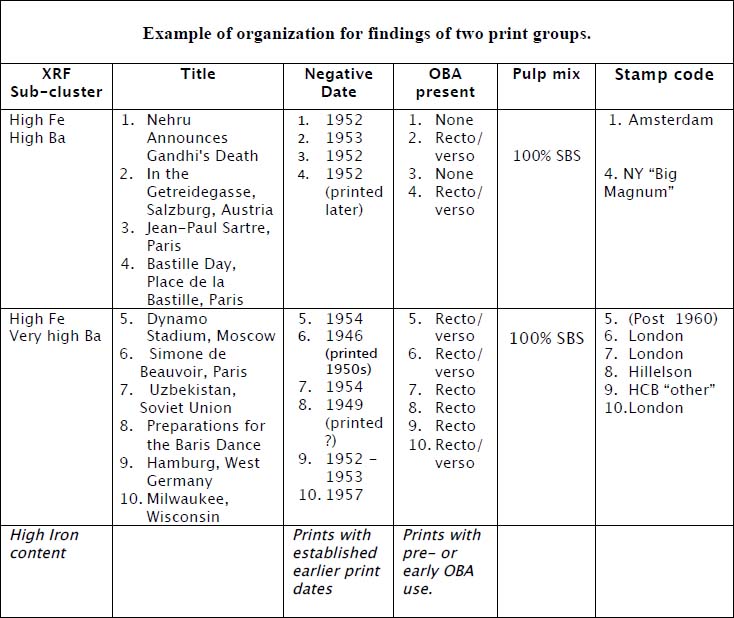
Topics in Photographic Preservation 2011, Volume 14, Article 29 (pp. 186-193)
Presented at the 2011 PMG Winter Meeting in Ottawa, Canada
In April 2009, The Museum of Modern Art opened Henri Cartier-Bresson: the Modern Century, a major retrospective of the photographer’s career. In preparation for the exhibition, 220 Cartier-Bresson photographs were studied in conservation to help narrow the print dates. First, stamps on the verso and other visual characteristics were tabulated and optical brightening agents were evaluated under long wave ultraviolet illumination for all 220 photographs. Fiber analysis and X-ray fluorescence spectroscopy were carried out on a carefully selected core group and a statistical approach was used to reveal common features amongst prints. Based on this combined evidence, a large portion of the photographs were assigned more precise dates.
Photo journalist, co-founder of Magnum Photos Agency and largely considered one of the great photographers of the 20th century, Henri Cartier-Bresson had an uncanny talent for seizing images, making him a leading figure both in photography’s experimental modernism of the 1930s and the very different realm of photojournalism after World War II (Galassi, 2010).
In April, 2010, Henry Cartier-Bresson: the Modern Century opened at The Museum of Modern Art in New York (MoMA). Organized by then chief curator of photography Peter Galassi, the exhibition drew upon previously inaccessible information and images from the Henri Cartier-Bresson Foundation (FHCB) in Paris, which loaned 220 of the 300 photographs in this exhibition. This was the first major retrospective since the photographer’s death in 2004.
The FHCB photographs arrived in New York eight weeks in advance of the exhibition for on-site matting and framing. This window of time before they were scheduled for framing, presented a rare opportunity to study the prints and assess a set of analytic techniques on a large body of work for the sole purpose of dating the prints. There was a strong curatorial interest to improve and confirm the actual print date for the exhibition labels; MoMA includes both negative and print date whenever possible. The FHCB photographs, however, had a negative date, but varied categories of print date: sometimes a date range was provided, such as “`1960’s 1970’s or “ca. 1970. A few had very good provenance and dates, but in general it was a mixed assortment. The project discussed in this article focuses on our attempt to refine the print dates of the FHCB photographs. We proposed to study the composition of the photographic papers to examine the prints for the presence of optical brighteners, inorganic content, and pulp type. To carry out this study, FHCB granted the conservation department permission to take a small number of paper fiber samples and carry out X-ray fluorescence (XRF). All the information, raw data and conclusions from this study was given to the FHCB at the end of the project.
There are a growing number of characterization projects on gelatin silver print materials utilizing varied analytic approaches. Listed below is a selection of studies starting with Messier and Baas (1998) on optical brightening agents in photographic papers, which grew from a series of questions in the fine art photography market. The MoMA Cartier-Bresson project is part of this continuum in characterization.

First the presence of optical brightening agents (OBAs) was determined by using a Stroblite Co. long-wave ultraviolet illumination light on both the recto and verso of all the prints. Eight categories were assigned using terminology determined to be descriptive for this group. To note degree of fluorescence, the descriptors “Faint”, “Moderate”, “Bright” and “None” were used. To note character of the fluorescence, a print was determined to be “Even”, “Mottled”, to have “Sheet marks”, or simply to have “Spots”. A wide range of fluorescence intensity and pattern combinations were noted, however due to pressing exhibition-related tasks, the survey results were further simplified to a “Yes” or “No”: was the fluorescence observed or not? In addition, very faint fluorescence was acknowledged in the survey to factor the early use of OBAs. Optical brightening agents are more likely to appear on recto-only in the 1950’s and by the 1960’s are more likely to appear on both recto and verso (Messier, Baas 2005). Based on this research, preliminary dates were assigned to the HCB photographs.
It was necessary to further organize the photographs into meaningful groups. Most of the prints from the FHCB had Magnum stamps and on occasion publication markers. The goal of the back stamp survey was to identify, when possible, the earliest stamp present and attempt to assign a city or country of origin to the print. Magnum had offices in Paris, New York, London and Tokyo and historically they would produce publicity and distribution prints to send to targeted periodicals (Galassi 2010). On occasion, we encountered a dated reproduction stamp (i.e. “Copyright 1963 Vogue”). In addition, there were a group of prints with known dates supported by solid provenance. These prints proved critical in forming a core reference group. Thus, with a working premise that a given Magnum office would have prints produced which used locally available photographic papers, a core group was created that cross-referenced all possible combinations of stamps, themes and OBA observations. This core group consisted of 26 photographs which had one or more of the following characteristics:
Fiber samples were taken from the 26 core group prints and sent to Integrated Paper Services Forensic paper scientists in Appleton Wisconsin for fiber analysis. The results indicated papers composed primarily of softwood bleached sulfite fibers from Spruce or Hemlock trees. This paper composition is typical of papers made between 1940 and 1970. For the queries surrounding this group of photographs, the fiber data was of limited interpretive value.
XRF was conducted on the 26 prints from the core group with a Tracer III-V Keymaster/Bruker (Re target X-Ray tube, Si PIN detector, operated at 15 KeV and 17mA and using a vacuum pump) and was carried out on the verso for higher sensitivity to low atomic weight elements in the paper. The same characteristic elements were found in all the photographic papers: Ag is present in the image layer, Ba and Sr come from the baryta layer (Stulik and Messier 2004), and Si, K, Ca, Fe, Ti are usually associated with the presence of fillers (Martins et al 2010), pigments and sizing precipitants in the paper (Browning 1977).
Although these elements are found in practically all the papers, XRF data shows that their relative abundance varies. These variations were examined using multivariate analysis (The Unscrambler® X CAMO software) to look for similarities between the papers. Principal Component Analysis (PCA) was performed on the pre-processed spectra (baseline correction and peak normalization) to successfully differentiate the papers according to their inorganic content.
The PCA scores plot in figure 1 shows that six different clusters could be identified, corresponding to six different groups of photographic papers with common properties.
Independent studies using XRF (Martins, McGlinchey et al, 2010) have shown that Ti is found in papers after 1960, while papers prior to 1940s may contain higher amounts of Si, K, and Fe.

Figure 1: Results of PCA analysis on the XRF spectra evidencing six different clusters corresponding to six different groups of prints. Discrimination along PC1 is related to the presence of Ti in the papers, PC2 (not shown) discriminates paper based on the content in Ba, and PC3 according to their content in K, Si, Ca and Fe.
Results from XRF clustering, fiber analysis, ultraviolet illumination examination, provenance information, stamps and title were organized. A simple sorting system was used for core group photographs in each cluster and distinctive properties, a partial sampling is illustrated in table 1. All combined, the information can help establish a probable date range.
Organization of findings for early prints

Table 1. Showing organization of data and clustering of core group photographs, which show commonalities in relatively early papers from the group.
Once the core group data was studied and reviewed, date assignments based on relationship and interconnections to all the photographs were outlined. In some cases the date assignments were sweeping, such photograph from thematic photo essays, such as Cartier-Bresson’s 1959 “Red China Bid for a Future: Young and Old Join in The Great Leap Forward’” which appeared in Life Magazine on January 5, 1959. Prints from this project in the core group appeared primarily in one main cluster, strongly characteristic of papers produced in the late 1950s, which made date assignments straightforward. In other groups and a few individual examples, dating continued to be based on individual observations, or remained difficult or elusive.
Summary MoMA Conservation Dating for 220 Henri Cartier-Bresson Foundation Photographs

Eighteen prints already had known dates to begin with. For 111 photographs, the date range was narrowed from a wide span such as “1960s – 1970’s down to “1960s”. For 78 photographs, a more precise date assignment was made. In this case it could vary from assigning “1960”or “ca. 1960” or even early 1960’s. Seven prints had total date change. For example one print had date of 1995, but material findings in the print were more consistent with a print from the 1950s. And lastly, there were six prints that could not be assigned a new date based on inconclusive evidence.
Our report, raw data and date assignments have been sent to the Foundation and we anticipate ongoing refinement of this data. This short but intense project provided a real world situation to engage emerging methodologies. Through this process, we discovered this clustering approach to be both viable and appropriate for our characterization studies.
Peter Galassi, Anne Cartier-Bresson, Agnès Sire, Pauline Vermare, Rosina Herrera, Dan Leers, Paul Messier, Hanako Murata, Greg Hill, Matthew L. Clarke, Connie McCabe and Clara Bouveresse
Bartels, K. 2004. Die Ergänzung und Retusche an vier Fotografien auf Silbergelatinepapier aus den 1920er und 1930er Jahren Betrachtungen ihrer Struktur und Oberfläche in Bezug zur Bildwirkung. Ein Beitrag von Kerstin Bartels, Berlin. http://www.uni-muenster.de/Forum-Bestandserhaltung/kons-restaurierung/vdr04_12.html (accessed 10/14/11)
Browning, B.L. 1977. Analysis of Paper, 2nd ed. revised and expanded. M. Dekker. New York.
Cartier-Bresson, A. 2009. Provenance et authentification des épreuves photographiques d’Henri Cartier-Bresson. In Revoir Henri Cartier-Bresson, eds. A. Cartier-Bresson and J.P. Montier. Paris: Éditions Textuel. 138-157.
Chen, J.J. 2003. Edge Reflection Analysis (ERA): A New Technique for Non-contact Texture Analysis of Glossy Surfaces. Research Project Presentation at the Andrew W. Mellon Advance Residency Program in Photograph Conservation. Rochester, NY.
Daffner, L. 2010. The Thomas Walther Collection Project: Characterization and collaboration at the Museum of Modern Art. Paper presented at the Andrew W. Mellon series of Collaborative Workshops in Photograph Conservation: Characterization of Silver Gelatin Photographs. New York, NY.
Daffner, L. and P. Messier. 2009. New applications for paper fiber analysis in characterizing photographs. Paper presented at Photographic Materials Group of the American Institute for Conservation Winter Conference. Tucson, AZ.
Dune, C., L. Grinde, and R. Wiegandt. 2005. Characterization of Black and White Silver Gelatin Fiber-based Photographic Prints. Research Project Presentation at the Andrew W. Mellon Advance Residency Program in Photograph Conservation. Rochester, NY.
Galassi, P. 2010. Henri Cartier-Bresson: the modern century. New York: The Museum of Modern Art.
Martins, A. and C, McGlinchey, L. Daffner, P. Messier, A. Chapman. 2010. Characterization of Silver Gelatin Fiber based photographic papers using X-Ray fluorescence spectroscopy. Paper presented at the Denver X-ray Conference. Denver, CO.
Martins, A. 2010. Characterization projects at MoMA: Analysis and Chemometrics. Paper presented at the Andrew W. Mellon series of Collaborative Workshops in Photograph Conservation: Characterization of Silver Gelatin Photographs. New York, NY.
Martins, A., Daffner, L.A, Fenech, A., McGlinchey, C., Strlič, M. Non-Destructive Dating of Fiber Based Gelatin Silver Prints Using Near Infrared Spectroscopy and Multivariate Analysis Analytical and Bioanalytical Chemistry, DOI: 10.1007/s00216-011-5566-2
Messier, P., and V. Baas, D. Tafilowski, L. Varga. 2005. Optical brightening agents in photographic paper. Journal of the American Institute for Conservation 44 (1): 1-12.
Messier, P. 2009. A technical analysis of Le Violon d’Ingres. In The long arm of coincidence: selections from the Rosalind and Melvin Jacobs Collection. New York: Steidl.
Passafiume, T. 2001. A Silver Gelatin DOP Sample Book and a Characteristic Catalogue of the Edward Weston Collection at George Eastman House. Research Project Prexsentation at the Andrew W. Mellon Advance Residency Program in Photograph Conservation. Rochester, NY.
Pollmeier, K. and J. Arney. 2001. Edge reflection analysis: a new technique for the documentation and characterization of photographic and other glossy surfaces. Paper presented at the International Institute for Conservation of Historic and Artistic Works Conference: Works of art on paper. Baltimore.
Stulik, D and P. Messier. 2004. Quantitative XRF study of baryta coated photographic paper. Paper presented at the Photographic Materials Group of the American Institute for Conservation meeting. Portland, OR.
Tragni, C.B. 2005. Use of Ultraviolet-induced Visible Fluorescence for Examination of Photographs. Research Project Presentation at the Andrew W. Mellon Advance Residency Program in Photograph Conservation. Rochester, NY.
LEE ANN DAFFNER AND ANA MARTINS AND CHRIS MCGLINCHEY
The Museum of Modern Art
Papers presented at Topics in Photographic Preservation, Volume Fourteen have not undergone a formal process of peer review.